Disclosure: Meeple Mountain received a free copy of this product in exchange for an honest, unbiased review. This review is not intended to be an endorsement.
After wrapping up my first play of the coffee business simulation Coffee Traders (2021, Capstone Games), I looked at the clock. Three and a half hours had gone by during this five-player game, and some of the players looked like they were going to have a lot of thoughts during the postgame discussion.
I was right. That’s because Coffee Traders wants to be a lot of things, and thanks to its impressive potential, our group found that some elements worked well while others did not. In this way, Coffee Traders was a surprisingly frustrating experience. The rules overhead is significant, and the age-old question surfaced a lot throughout each round:
Is the bean worth the grind? (In coffee terms: is the 24-minute line at Starbucks worth the wait?)
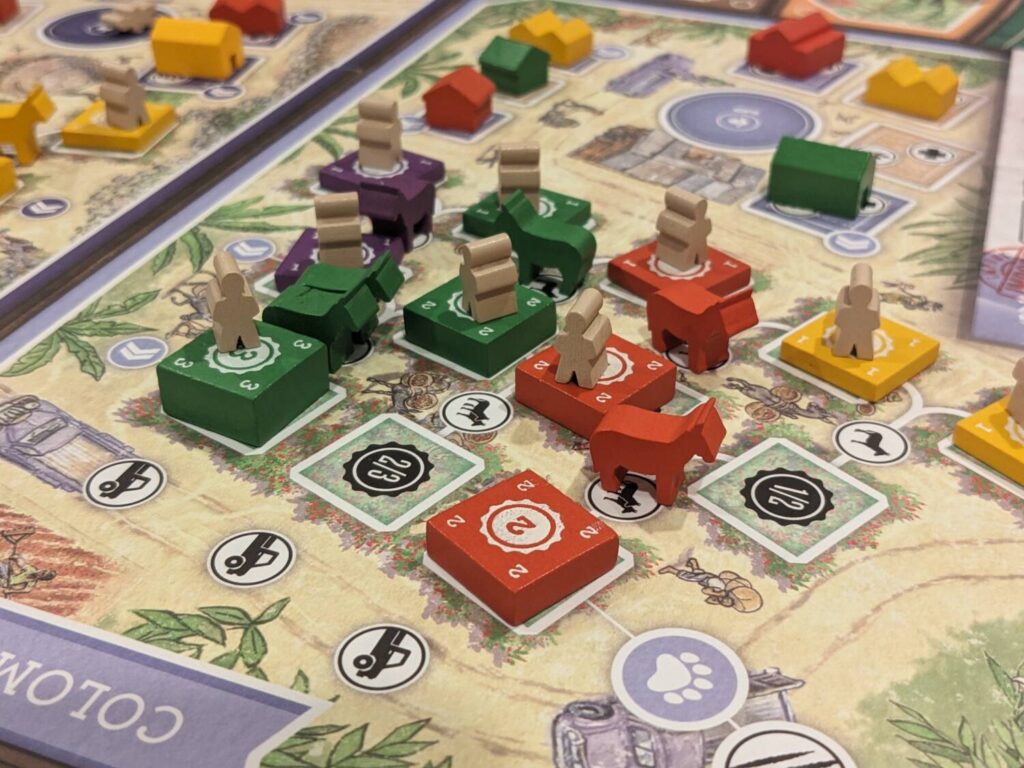
Game in a Nutshell (or a Coffee Bean)
Coffee Traders is an economic area control Eurogame for 2-5 players that takes about three hours to play. Coffee Traders features the use of a dummy player in two-player games, so it’s safe to say that Coffee Traders is really a 3-5 player game.
The game opens in 1970. Over the course of three rounds (six phases per round), players lead their fledgling coffee business into the plantations of five different countries to help build cooperatives and sell coffee to the foreign market as well as coffee bars around the world.
Each phase breaks up the action in vastly different ways. Players take actions and place workers onto empty plantations over the first two phases, helping to build out each cooperative while also staffing plantations with the local workforce and taking income actions. Phase 3, Trade & Build, gives players a chance to use their personal meeples as either contractors (to build things like fair trade posts, production houses and hospitals) or as traders, to gather coffee from each cooperative to sell to the market later.
Phase 4 is the Harvest. Plantations produce, and fair trade posts and traders collect their share of the bounty. In Phase 5, players sell their resources to fulfill contracts or satisfy the needs of the world’s coffee bars. The coffee bar tracks double as an area majority mechanic for endgame scoring. Upkeep takes place in Phase 6 (the Refresh Phase), which serves as a relatively quick clean-up phase before moving to the next round.
Endgame scoring is…well, it’s a bit of a mess. I will come back to this later, but know that players score for almost everything in Coffee Traders, and sadly this is not an easy process. Between area majorities in both the coffee bar market as well as each of the five cooperatives, milestone scoring, scoring on the Arabica track, scoring for leftover non-cash resources, and a host of other items, Coffee Traders has one of the most involved endgame scoring mechanics I have seen in a while.

What Worked?
The production of Coffee Traders is exceptional.
That starts with a table presence that is the most colorful, heavy strategy game I have ever played. At five players, with the rich board, various scoring areas, the tracks, and the milestones, this game has a visual punch in spades. Sure, the board takes up a comical amount of real estate—when adding the individual foldout player boards, it was a challenge to even get this to fit on my table.
But everything about the look and feel works. The wooden components make Coffee Traders a weight-bearing nightmare, but I can’t think of any pieces I would eliminate to streamline the production. In particular, the donkeys (used to identify the paths between a player’s plantations in each cooperative), the trucks, and the civet tokens (which call out production of the game’s wild coffee resource, kopi luwak) all shine.
The included metal coins are the right call here, too. Money is tight (particularly early in the game), so these coins are small but weighty. There’s a score pad included to track the endgame scoring totals, and that pad has a lot of paper. Sure, there are too many scoring categories, but the pad does a good job of laying out the scoring requirements in a meaningful way.
I had only two issues with the production. First, the lack of player aids is shocking. The game needs player aids because there are so many minor rules.
Second, the game needed a better way to track the production of coffee in each cooperative, so that it would be easier to tell at a glance how much coffee will be assigned to the traders during that part of the Harvest phase. As it was, we used one player’s leftover coffee bar/milestone scoring chips. Not smooth, but it did the job.
In terms of the gameplay, the two phases that proved to be the most exciting were Phases 3 and 4, the Trade & Build and Harvest Phases. In particular, Trade & Build is why Coffee Traders showed such promise.
Each player is limited to three meeples when play begins, with a fourth meeple available in the Bonus Supply area. That means in the first round, everyone has 3-4 chances to either send a meeple as a Trader to a cooperative to gather coffee, or as a Contractor to build one of three buildings: fair trade posts, production buildings, or warehouses.
The act of sending a meeple to perform an action in any board game isn’t thrilling. But the game’s “Piggyback” action, similar to “follow” or “executive” actions in Vital Lacerda games such as The Gallerist, makes the Trade & Build action suddenly quite interesting. When player A decides to build a building in the Ethiopia cooperative, successive players get to follow by paying one coffee resource of their choice to the active player in order to build a building in the same cooperative.
When the active player decides to place a Trader, others can Piggyback off of this action for free, but they will be later in turn order and will get less coffee than the active player. But that’s still juicy, particularly in a cooperative that is going to produce a bunch of coffee in that round.
In a five-player game, things get tight in the building space relatively quickly. And only four players can trade in a cooperative in five-player games, so one player is automatically going to be squeezed out in each round.
Trade & Build? Fascinating, and it has elements of other games ripped off in an interesting way, particularly the Mayor action from Puerto Rico. If the entirety of Coffee Traders was just the Trade & Build phase, we are talking about a game I could see regularly hitting my table.
The Harvest Phase builds on the Trade & Build phase by watching players yield the fruits of their labor. Or, more accurately, yield the fruits of other players’ labor. That’s because anyone can trade in any cooperative, even ones where players don’t have a plantation. That means that in some rounds, I am swooping in to get a bunch of coffee in a place where I have zero board presence. Sure, I won’t score any area majority points in that cooperative at the end of play, but who cares if I can get enough coffee to fulfill a bunch of my contracts??
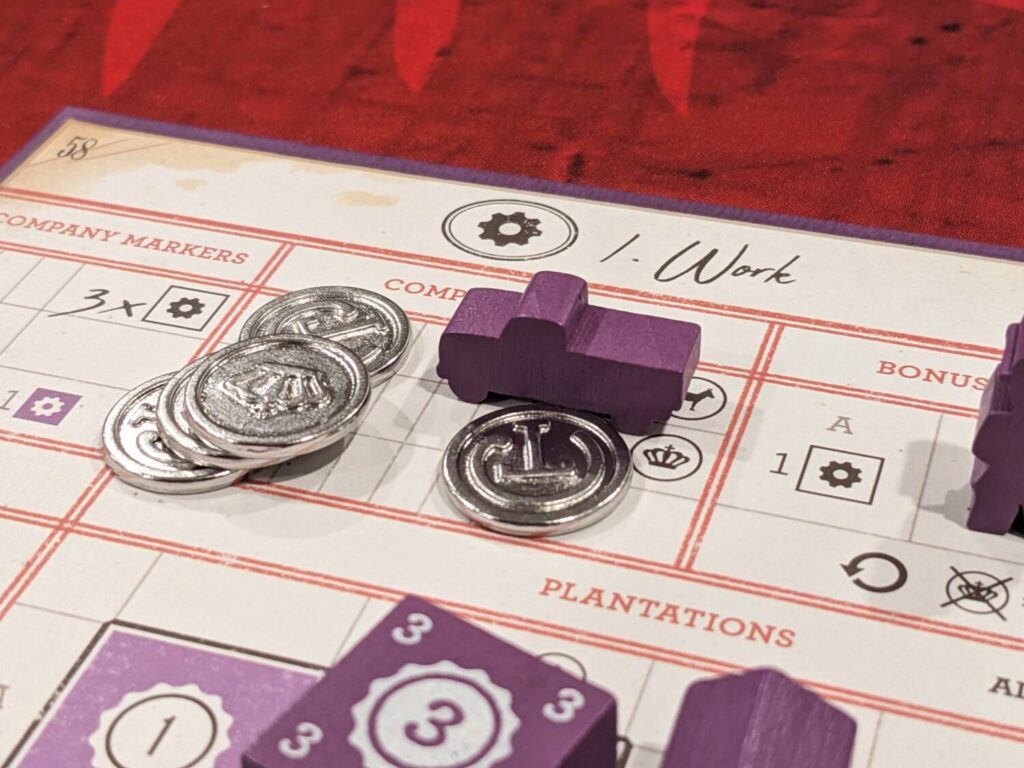
What Didn’t Work?
It’s not worth the space here to call out a rulebook that might be the most infamous ruleset of the last few years, if not ever. Even a brief glimpse at online forums about the Coffee Traders rulebook will yield all you need to know about its disastrous arrival. Capstone did swoop in to save the day by basically rebuilding the rulebook into a “v1.5” that addressed many of the problems of the original rulebook.
That said, the newer version isn’t perfect and the layout might be the biggest offender. Coffee Traders is a rules-heavy experience, and the rulebook just isn’t laid out very well. I was surprised how much time I had to spend reciting rules to players during our game, and looking for those rules in the book isn’t easy. This is another area where the lack of player aids really hurt.
So, the rulebook was a problem, but I would contend that even a well-designed and well-written rulebook wouldn’t stop the fact that some of these rules just feel way off.
The Counter Track is the worst offender. Even by the end of our five-player game, players were still asking questions about how the thing worked. I have no idea why the Counter Track is so complicated. Games like Mosaic: A Story of Civilization make the collection of counters easy—collect a lot of tokens from the board, and more tokens equals more points.
In Coffee Traders, you will occasionally grab tokens. But there are a shocking number of rules tied to which tokens allow for bumps on the Counter Track. I won’t dive deep here, but I’ll just call out that this track just didn’t land for our group.
Bonus Supply? I have thoughts. The Bonus Supply has three items, with only two of these three available to use during a round:
- A fourth action token, used during Phase 1.
- An extra meeple, to be used as a Trader or a Contractor during Phase 3.
- Three coins.
If an item is ever returned to this area—such as when your meeple area of the Bonus Supply is empty, but you later unlock a meeple to add back to the Bonus Supply—you are once again eligible to exhaust the two other resources if you can.
First, let’s talk about the fourth action token (each player has access to three action tokens by default). More actions are good. There’s no penalty to taking a fourth action. One action is income, which grants a player two coins. In a game this tight with money, income is good.
You are always going to need that fourth action.
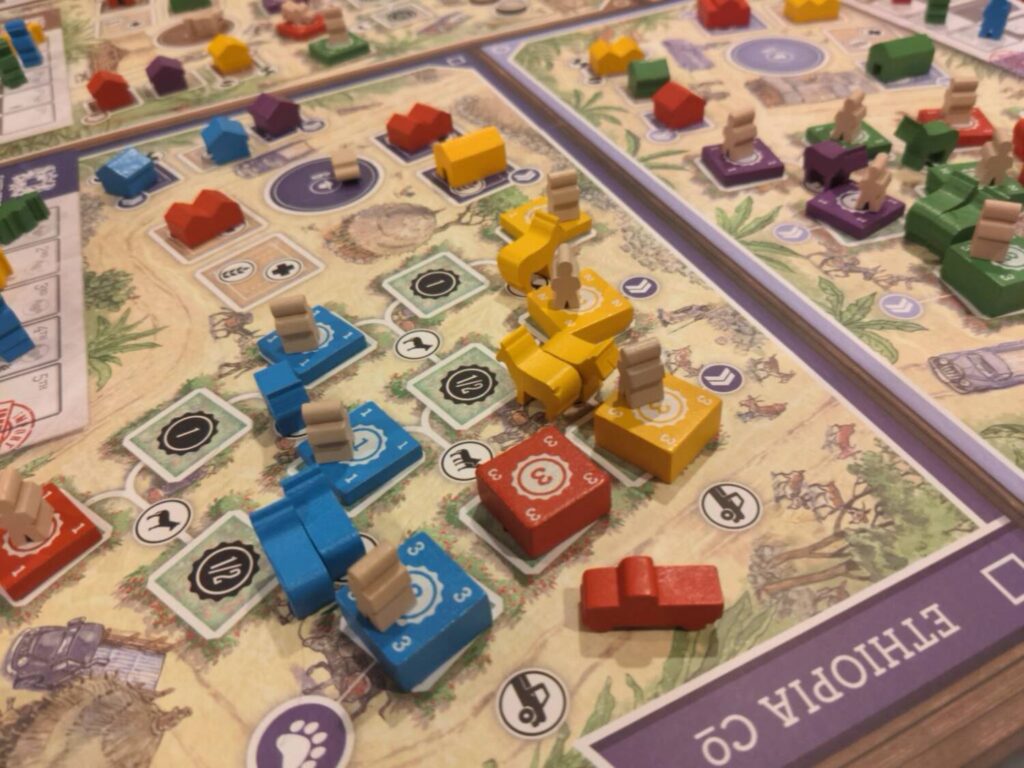
Why not just give each player the fourth action? In each of our rounds, players always used this fourth action, and in such a short action efficiency section of play, it feels right that players will be desperately looking to take all the actions they can.
Second, the three coins. If you ever borrow from your Bonus Supply, you have to take all three coins. At the end of the round, you need to pay three coins back into the Bonus Supply or you lose THREE POINTS per missing coin.
Why not institute a loan system? Without it, Coffee Traders feels a bit like Agricola at the end of each round, “awarding” Begging Points as a penalty for players that can’t refill the kitty in time. A loan system would feel more appropriate to me—this is an economic simulation of the coffee business, after all—and still stress the importance of money management.
Let’s talk about the plantation worker pool for a moment. At first, we thought it was a mistake, but we watched the excellent Game in a Nutshell video to ensure we had this right. Getting new workers into the supply in Coffee Traders felt exceptionally difficult, particularly in round two. That left lots of our plantations unstaffed as players tried to figure out how to activate enough bonuses from their completed milestones and Arabica tracks.
Thematically, this feels off. As the coffee business grew from 1970 to 1980, my sense is that the coffee business began to explode. Wouldn’t that mean that labor was an easy fix in each of the countries used in this game? Am I really running a business in a place where finding workers is going to be thistight?
I would have removed the worker element from Coffee Traders altogether. It was design choices like this (from Rolf Sagel and André Spil, the duo that designed Wildcatters) that elicited questions from my play group…some of these choices appear to exist only to complicate the game. Why not just make the plantations operational once a player can afford to buy it? Make the costs higher, limit the number of plantations—something.
The other thing that didn’t land for our group came during final scoring. There’s just no way around it, a bit like the end of a game of Brass: Lancashire when you’ve got to count up the points/money that come from each player’s rail tokens and buildings on the map. Coffee Traders has that, but it has six other things that you’ll need to score in a way that feels much too manual.
Now, the upside here (if this appeals to you) is that players won’t have much sense of where other players are, in terms of their score. Sure, you’ll be able to eyeball some of the area control scoring on the coffee bars and cooperatives areas, and the three public milestones show which players have scored those too. But it’s hard to math out everything, in a game where our scores ranged from the mid-80s to north of 150 points.
That’s great if you are in last place, because you just think you are losing, instead of getting demolished. (Believe it or not, I think that’s a positive.) But it would help to know where you are fighting with close competitors, and there are simply too many fronts to consider in the final analysis.
You want to compete on the cooperatives, but we found that everyone was in the running for two of the five, maybe three. (A fundamental element of area control—play for second place in every region, if possible. In Coffee Traders, due to the lack of actions and the costs of starting plantations in the regions where you don’t begin the game, we found that to be a considerable challenge.)
At a glance, it is somewhat easy to tell how many contracts opponents have completed, or how many buildings they have built, but again, it’s hard to math this out. So players just try to score as much as they can in a variety of areas and hope for the best. What I would have preferred: a chance to really compete against a player in specific areas, by closing them out of certain actions first. But there’s so much space in Coffee Traders to do so much…the game almost has a sandbox/point salad approach to its scoring, so competition is a loose term in this format.
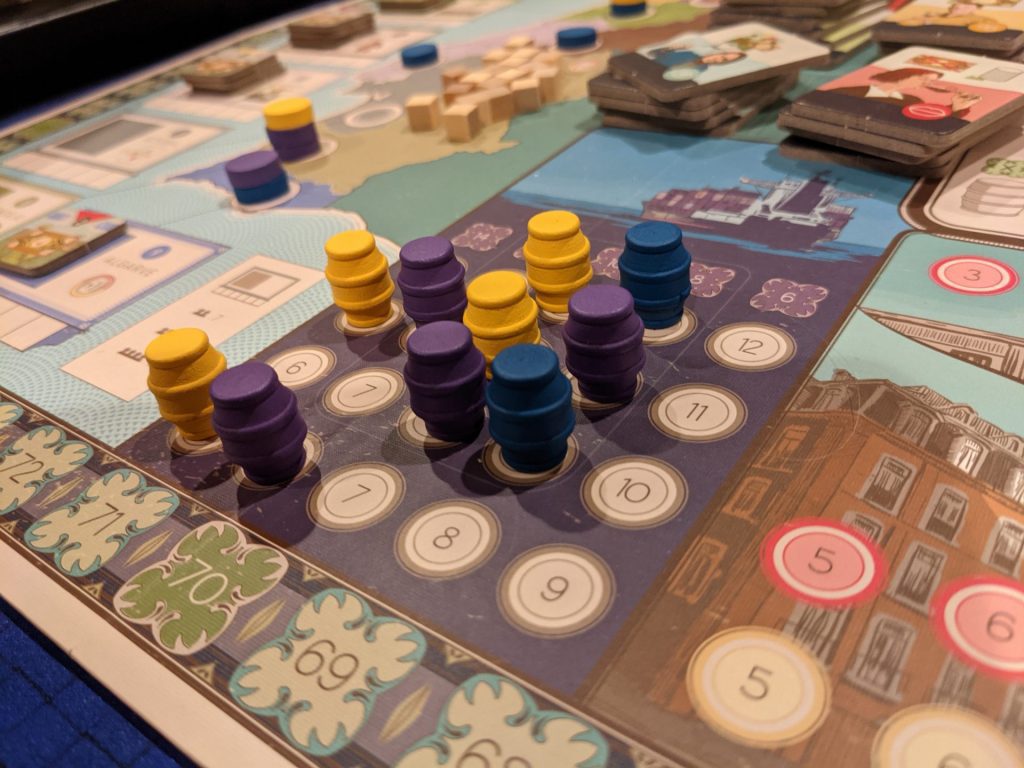
I Needed to Know!
Coffee Traders came out almost three years ago, and when it first arrived, I expected it to make more of a splash. Given that it was published by Capstone Games, the premier publisher of medium-to-heavy strategy games in the US, I have had it on my list to try for some time now.
But as of this writing, Coffee Traders ranks in the mid-1100s on BGG’s list of games. I had a slightly harder time finding players willing to try it than I expected, and after our five-player game, two of the other four players said flat-out they would not want to play it again.
Now that I’ve played Coffee Traders, I absolutely see some of the concerns that others had about the game. It does have a market, but competition for complex, economic Euros is so fierce right now! Even during our play of Coffee Traders, one player mentioned Vinhos: Deluxe Edition and The Gallerist that shared some of the mechanics (particularly around the coffee bar area control scoring tied to similar processes in those Lacerda games), and I’ve mentioned Brass already during this review.
But I really liked the theme of Coffee Traders, and I liked the idea that a player could put in so much work to pump out coffee in a particular region only to be snuffed out of being able to sell that coffee to the world. It felt like stealing. It probably happened in real life that way at some point, and there’s a business behind it that could reward other factions. This felt right, even if it didn’t feel fair. The coffee bar area lets players who can’t fulfill contracts continue to profit off of their business, and maybe score points at the end of the game to boot.
I’m not a fan of the scoring system here, but I get the sense that others will love that more than I do. With a group that plays this game regularly, I could see the playtime coming down quite a bit. Five players didn’t add to the experience here, so I’m more likely to try this again at three players instead to see what changes.
Coffee Traders has an array of great ideas, particularly during Phases 3 and 4 of each round. It’s unfortunate that those ideas are often buried behind so many rules, because the overall production is so sensational.


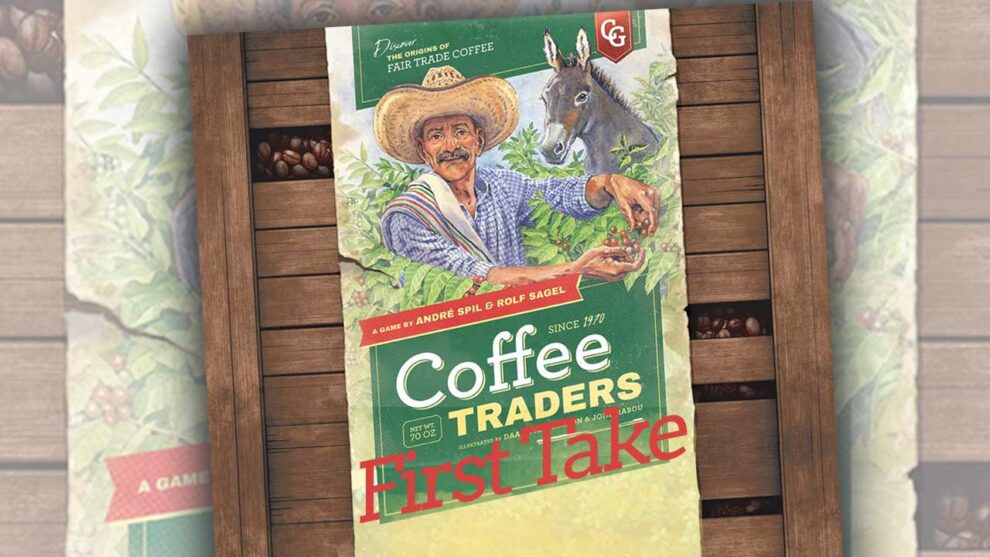









Add Comment